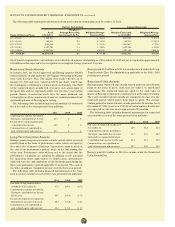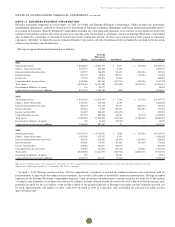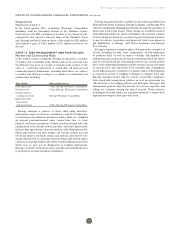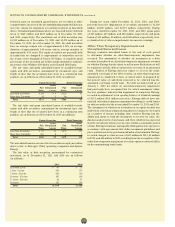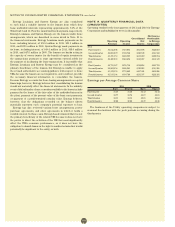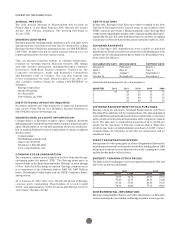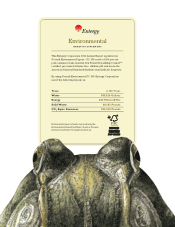Entergy 2011 Annual Report Download - page 108
Download and view the complete annual report
Please find page 108 of the 2011 Entergy annual report below. You can navigate through the pages in the report by either clicking on the pages listed below, or by using the keyword search tool below to find specific information within the annual report.
NOTES TO CONSOLIDATED FINANCIAL STATEMENTS continued
Fair Values
The estimated fair values of Entergy’s financial instruments and
derivatives are determined using bid prices, market quotes, and
financial modeling. Considerable judgment is required in developing
the estimates of fair value. Therefore, estimates are not necessarily
indicative of the amounts that Entergy could realize in a current
market exchange. Gains or losses realized on financial instruments
other than forward energy contracts held by competitive businesses
are reflected in future rates and therefore do not accrue to the
benefit or detriment of shareholders. Entergy considers the carrying
amounts of most financial instruments classified as current assets
and liabilities to be a reasonable estimate of their fair value because
of the short maturity of these instruments.
Accounting standards define fair value as an exit price, or the price
that would be received to sell an asset or the amount that would
be paid to transfer a liability in an orderly transaction between
knowledgeable market participants at the date of measurement.
Entergy and the Registrant Subsidiaries use assumptions or market
input data that market participants would use in pricing assets
or liabilities at fair value. The inputs can be readily observable,
corroborated by market data, or generally unobservable. Entergy
and the Registrant Subsidiaries endeavor to use the best available
information to determine fair value.
Accounting standards establish a fair value hierarchy that
prioritizes the inputs used to measure fair value. The hierarchy
establishes the highest priority for unadjusted market quotes in
an active market for the identical asset or liability and the lowest
priority for unobservable inputs. The three levels of the fair value
hierarchy are:
n Level 1 - Level 1 inputs are unadjusted quoted prices in active
markets for identical assets or liabilities that the entity has the
ability to access at the measurement date. Active markets are
those in which transactions for the asset or liability occur in
sufficient frequency and volume to provide pricing information on
an ongoing basis. Level 1 primarily consists of individually owned
common stocks, cash equivalents, debt instruments, and gas hedge
contracts.
n Level 2 - Level 2 inputs are inputs other than quoted prices included
in Level 1 that are, either directly or indirectly, observable for the
asset or liability at the measurement date. Assets are valued based
on prices derived by independent third parties that use inputs such
as benchmark yields, reported trades, broker/dealer quotes, and
issuer spreads. Prices are reviewed and can be challenged with the
independent parties and/or overridden by Entergy if it is believed
such would be more reflective of fair value. Level 2 inputs include
the following:
n quoted prices for similar assets or liabilities in
active markets;
n quoted prices for identical assets or liabilities in
inactive markets;
n inputs other than quoted prices that are observable
for the asset or liability; or
n inputs that are derived principally from or corroborated
by observable market data by correlation or other means.
Level 2 consists primarily of individually owned debt instruments or
shares in common trusts. Common trust funds are stated at estimated
fair value based on the fair market value of the underlying investments.
n Level 3 - Level 3 inputs are pricing inputs that are generally less
observable or unobservable from objective sources. These inputs
are used with internally developed methodologies to produce
management’s best estimate of fair value for the asset or liability.
Level 3 consists primarily of derivative power contracts used as
cash flow hedges of power sales at merchant power plants.
The values for the cash flow hedges that are recorded as derivative
contract assets or liabilities are based on both observable inputs
including public market prices and unobservable inputs such as
model-generated prices for longer-term markets and are classified
as Level 3 assets and liabilities. The amounts reflected as the fair
value of derivative assets or liabilities are based on the estimated
amount that the contracts are in-the-money at the balance sheet
date (treated as an asset) or out-of-the-money at the balance sheet
date (treated as a liability) and would equal the estimated amount
receivable or payable by Entergy if the contracts were settled at
that date. These derivative contracts include cash flow hedges
that swap fixed for floating cash flows for sales of the output from
Entergy’s Entergy Wholesale Commodities business. The fair values
are based on the mark-to-market comparison between the fixed
contract prices and the floating prices determined each period
from quoted forward power market prices and estimates regarding
the costs associated with the transportation of the power from the
plants’ bus bar to the contract’s point of delivery, generally a power
market hub, for the period thereafter. The differences between the
fixed price in the swap contract and these market-related prices
multiplied by the volume specified in the contract and discounted
at the counterparties’ credit adjusted risk free rate are recorded as
derivative contract assets or liabilities. As of December 31, 2011,
Entergy had in-the-money derivative contracts with a fair value
of $312 million with counterparties or their guarantor who are all
currently investment grade. As of December 31, 2011 there are no
out-of-the-money contracts supported by corporate guarantees,
which would require additional cash or letters of credit in the
event of a decrease in Entergy Corporation’s credit rating to below
investment grade.
106






